Drones in the Ukraine War. Part 4. Drones Are Massively Accessible.
Drones show up in war because they're cheap, easy to use, and available around the world.
While the consumer drone market has only really existed on a wide scale since the early 2010s, small unmanned aerial vehicles have already become a constant, ubiquitous presence in the skies over the 2022 Ukraine War. Fighters for both Ukraine and Russia now regularly refer to small, cheap consumer drones as absolutely vital tools that help them target artillery strikes, conduct reconnaissance, and generally stay alive.
Massive volunteer networks have sprung up to funnel off-the-shelf drones to fighters in both countries, and technologists are constantly hustling to hack and modify ready-built drones to make them safer to use in conflict zones filled with electronic-warfare based dangers. It all amounts to a huge amount of activity related to little flying robots that simply hasn’t been present in any other war in history - and war observers, months into the conflict, are probably wondering about a rather fundamental question: “Where did all these things come from?”
I’m here to help.
Here’s a brief, and of necessity massively abbreviated, history of little flying robots. 1

People often assume, mistakenly, that the small drones of today are in some way the direct descendants of the large, missile-equipped military drones that first became widely known to the public during the War on Terror after 9/11.
That’s not how it happened. It’s more like they both share a very distant ancestor. 2
The modern small, consumer drones that you can buy at the drug store today are largely the evolutionary descendants of the remote controlled aircraft hobby that exploded in popularity in the mid-20th century. While the first remote-controlled airplane, charmingly named “Big Guff” (for some whimsical interwar-era reason) took to the sky way back in 1938, model helicopters proved to be a much tougher nut to crack.
The first free-flight RC-helicopter (unconnected to a wire) were only really figured out by the late 1960s, after many years of experimentation and heart-breaking failure on the part of the model-airplane nerd community: it took until the early 1970s before RC helicopter kits became widely available on the global market. They almost immediately developed a reputation for being fiendishly difficult to fly - and occasionally, they even proved deadly. 3
Fiendish as these RC copters were, by 1980, Japanese forestry researchers had begun to experiment with using RC helicopters with cameras on them in their research work - and in their published paper, they hoped that the RC helicopters of the future would contain gyroscopes and other sensors that would make them a smidgen easier for mere mortals to use.
The first consumer quadcopter, Japan’s Keyence Gyrosaucer E-170, hit the commercial toy market way back in 1989, relying upon gyroscopes for stabilization. However, it came out before the first ultra-efficient consumer lithium-polymer, or LiPo, batteries hit the market in 1991, and it had a rather underwhelming 3 minute battery life - barely enough time to get it painfully tangled in your sibling’s hair.
While hobbyists continued to experiment with refining model airplanes and added computerized parts to them throughout the 1990s and early 2000s - and even figured out how to develop model aircraft that could broadcast wireless video signals - these proto-drones remained a rather niche, difficult-to-use pursuit for a very specific kind of engineering-minded nerd.
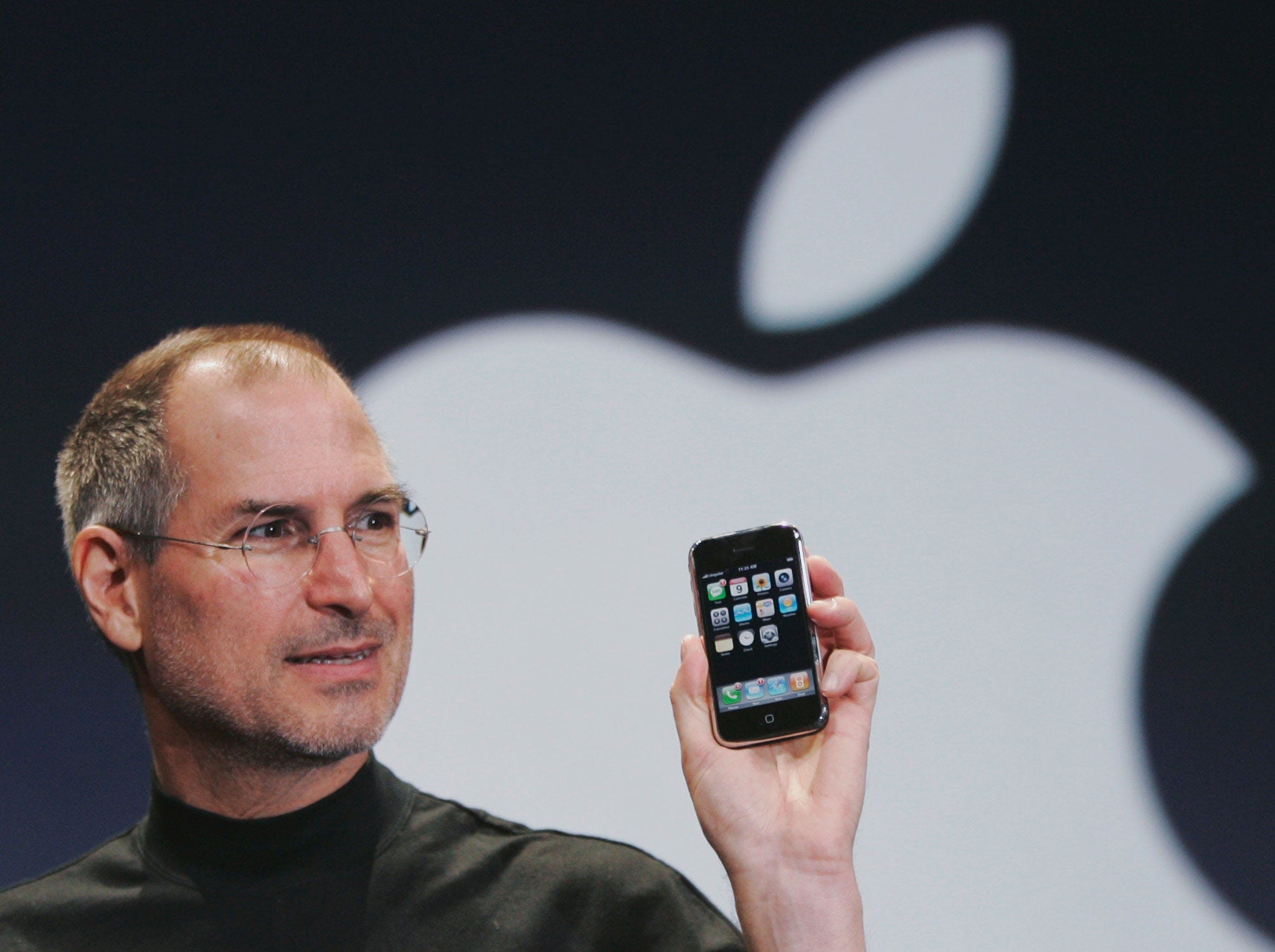
Flash-forward to January 9, 2007, as a turtleneck-wearing Steve Jobs ascends the stage at the Macworld conference and pulls out the curious little black hand-computer that will, very swiftly, eat the entire world’s brain.
The smartphone revolution was possible because by 2007, we’d become extremely good at building ever-tinier microprocessors. The exceedingly small ARM chips that the iPhone used allowed it to do various computer-things, from taking photos of your sandwich to poking your friends in Facebook - all while drawing so little power that the phone could hold a charge for hours on end. To pair with all that teeny-tiny processing innovation, we’d also become very good at developing ever-tinier GPS receivers, devices which permitted smartphones, and the people who used them, to know where they were in space.
We’d also developed miniature accelerometers that the first iPhone could use to sense the angle at which it was being held (allowing you to pretend to drink a virtual beer, oh, the 2000s-era hilarity!), and miniature compasses and gyroscopes that would help subsequent iPhone models locate themselves in space. Finally, we’d figured out how to build diminutive digital cameras that produced nice-enough results and could be jammed into exceedingly small bodies.
By the late 2000s, the stage was set for someone to figure out how to take all those tiny electronics, stick them onto a easy-to-use model quadcopter, and then sell gazillions of them to everybody with functioning thumbs. 4
Remote controlled airplane hobbyists had kept up with these remarkable improvements in tiny computers, and by early 2007, then-Wired editor Chris Anderson had launched DIY Drones (inspired by a Lego Mindstorm camera-carrying drone he’d built with his kids), a website that allowed computer-enabled airplane enthusiasts to chat with one another. The drone hobby began to develop at a furious clip.
Enter the French. At CES in Las Vegas in early 2010, France’s Parrot company released what would become, arguably, the first commercially mainstream consumer drone: the Parrot A.R, a neat, foam-built flying toy that could be controlled entirely via WiFi and an IOS app. However, the Parrot A.R. was largely only meant for indoor use (such as for annoying pets and siblings), and had a distinctly limited amount of utility for serious photographers or map makers.
2010 was too early. No, if you, for some sick and unfathomable reason, held a gun to my head and asked me to tell you exactly when the modern drone-saturated era truly began, I’d pinpoint that date to 2013.
2013 year when the world became truly introduced to drone journalism, after reporters and disaster responders published drone video of the devastation left behind by Typhoon Haiyan in the Philippines.
That year, drone videos of protests and police violence from Bangkok to Istanbul to New York City flashed around the world, and Ukrainian activists launched drones over Kyiv to record the massive turnout at the fateful Euromaidan protests. Right in time for Christmas 2013, Jeff Bezos announced that Amazon planned to take to the skies for drone delivery - a lofty promise that the company is still struggling to fulfill today.
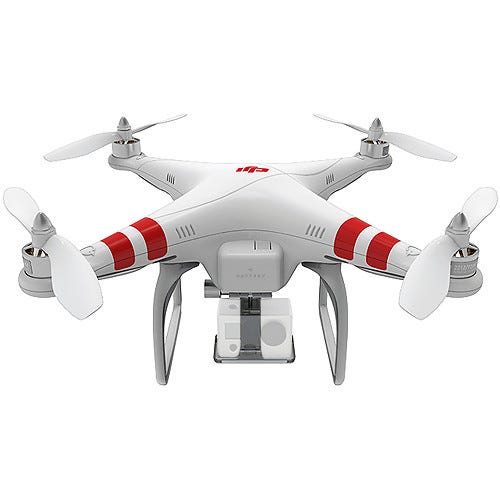
Finally, and no less importantly, 2013 was the year when China’s DJI, a relatively small company that had been trundling along since 2006 selling drone components to hobbyists, launched the first DJI Phantom into the global market. It was relatively inexpensive, priced at less than $900, and often selling for much less.
It could be equipped with a GoPro camera, which dangled below it and took nice-looking video of your aerial adventures, video you could then make your friends pretend to ooh and aah over while you played it on your smartphone. The Phantom looked friendly, with a pleasantly rounded white-and-red exterior that came off as far less intimidating than the exposed-wires and hot-glue, cyberpunk-esque appearance of most kit and home-built drones. It was an object that made people think more about taking a family drone-selfie on the beach at sunset, more than it made them think about personally reliving the key plot points of “Minority Report.”
And perhaps most importantly, unlike many other cheap consumer drones and custom-built drone models of the era, the DJI Phantom came with a built-in GPS receiver.
The GPS in conjunction with the drone’s computerized flight controller meant that the DJI Phantom had a general idea of where it was in relation to you, the pilot. If you took your hands off the control sticks, it would simply hover patiently in place, instead of drifting terrifyingly off in the direction of the prevailing wind, like most other remote-controlled quadcopters and model helicopters of the era.
It was even capable of automatically returning to a defined location if you flew it too far away, or if the battery charge dwindled too low. This was instrumental to DJI’s success: suddenly flying a drone was within reach of everyone, not just people who happened to have the patience (and reflexes) to fly a temperamental and complex home or kit-built drone.
By October 2013, a fast-moving DJI had also launched the Phantom 2 Vision, which came with its own 14-megapixel integrated camera, and (just as importantly) the ability to connect with a smartphone via Wi-Fi, giving the pilot a true first person view (FPV) perspective on where the aircraft was going. Via the screen, drone pilots could, in a certain sense, become the drone. They could see what it was seeing, follow along with its progress through the air, artfully frame shots as if they were up in the cockpit with it: experience the sensation of flying without shelling out for flying lessons, or risking potential fiery death.
Almost as soon as the first Phantom hit the marketplace, YouTube began to flood with sweet drone videos of surfers and snowboarders. Photographers began to snap them up. The hype, always of vital importance in the consumer tech world, began to build.
It’s hard to overstate how revolutionary the first DJI Phantoms were.
No, they weren’t the first quadcopters, or the first consumer quadcopters, or the first to be used for journalism, disaster relief, and mapping. (By 2013, as I mentioned above, many people using DIY-type, custom-built drones had been doing that for years). But the DJI Phantom was the first consumer quadcopters that combined being extremely easy to fly right out of the box with the ability to carry a camera that could produce truly impressive-looking results.
What’s more, the Phantom could fly for considerably further and for much longer than the toy-like Parrot A.R., opening up new worlds of possibilities for both bored hobbyists and professional photographers and map-makers. It was the first prosumer drone that the average schmuck could buy on the Internet, and that made all the difference.
2013 was also the year I saw my first drone, a stark-white DJI Phantom that hovered way above the manicured green lawns of the Stanford campus like some obscene alien hummingbird. I was fascinated by it. My destiny was sealed by a weird white plastic toy helicopter.
But then again, I wasn’t alone.
I was just one of millions of people around the world who started wondering at that exact point in history what a extremely inexpensive, flying smartphone with a nice camera on it could do for them. The drone revolution had begun in earnest, and a dizzying array of use cases for these small consumer-focused flying robots, from studying whale snot to mapping wineries to assisting police surveillance and furthering ISIS’s extremist agenda in Syria quickly followed. (Drones contain multitudes).
Which brings us to today. And the war in Ukraine.
DRONES ARE EVERYWHERE IN THE UKRAINE WAR
By the time the Ukraine War began in February 2022, consumer and hobby-built drones had thoroughly permeated just about country on Planet Earth, including the very few remaining holdouts where it’s still technically illegal to fly them.
Ukraine was one of the world’s earliest adopters of small drones for everything from journalism to territorial defense, dating all the way back to the start of the consumer drone era itself in the early 2010s. Ukraine has long had a remarkably tech-savvy, nerdy population, and Ukrainian hobbyists were into drones early. Deprived of the vast financial resources of the Russians, Ukrainian fighters quickly resorted to more DIY methods and consumer drones, including DJI models, after Russia’s first incursion into their territory back in 2014.
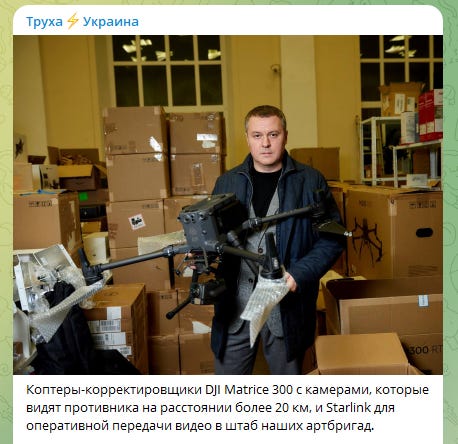
While Russia is home to its own contingent of drone nerds and hackers, Russian defense officials largely seemed to see little need to bother with using small, cheap drones in those days of less intense, border-based conflict with Ukraine. As soon as Russian troops began to rumble across the border in early 2022, Ukrainian fighters started using their long-practice small drone capacity to pummel the Russians in ways they didn’t entirely expect. It’s an imbalance that Russian forces - now far more desperate, strung-out, and willing to explore the possibilities of small drones than they were back in the 2010s - are still hustling to correct today.
The majority, even the vast majority, of the small drones swarming over Ukraine today are made by DJI. While some organizations, like famous Ukrainian volunteer drone outfit Aerorozvidka, build and deploy many of their own custom drones on the battlefield, and soldiers will largely take any functional quadcopter they can get, DJI drones remain both the most common and the most-desirable game in town for combatants seeking a dirt cheap, easy to use tool. On Telegram, soldiers sneer at the idea of being reduced to using cheap Aliexpress specials, junky knock-offs of DJI products: to keep them alive in combat, they want the real thing.
DJI is so popular in this war, and in every other modern small-drone war, not just because of how easy they are to use (which I’ve addressed above) but because they are so incredibly easy to get. It’s an unbeatable combination in a modern conflict that no one entirely expected to go on for this long.
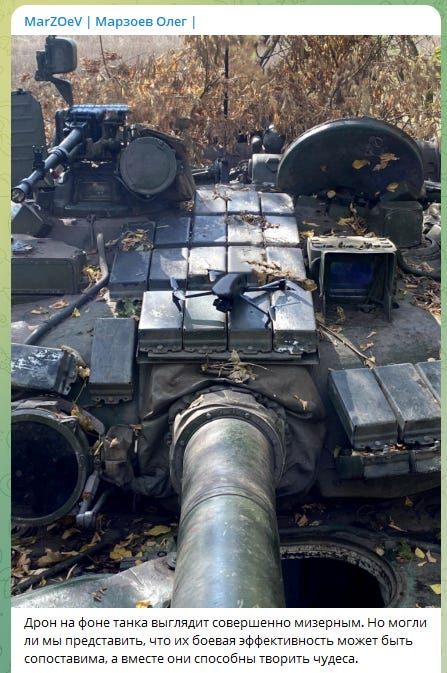
Of all the consumer drone makers selling drones all over the planet, DJI remains the biggest by a considerable margin. In data published in September 2021 by DroneAnalyst, the company - even after a 15 point drop from 2020 - held 54% of the world’s commercial drone market. (Other data sources claim that DJI holds a much bigger 76%, or as much as 80% of the global market).
Up until Russia invaded in early 2022, DJI sold drones in both Ukraine and in Russia, both for hobby purposes and for industry users, including farmers, map-makers, and videographers. That official trade came to stop in late April 2022, when DJI announced that it would be halting sales in both countries.
Ever since then, DJI products have been entering Ukraine and Russia by other, unofficial means. And since DJI products are so globally popular and widely-sold, buying them abroad from one of the sea of suppliers and bringing them in over the border has, largely, been relatively easy to do for the hundreds of largely Telegram-based volunteer networks that have sprung up in both countries, working to funnel drones to fighters on the front lines. 5
This is not something that DJI is thrilled about. Even though it’s making them money.
I could write a much-longer piece on the complex, controversial nature of DJI’s relationship to global affairs, war, and the Chinese government, but for the purposes of this piece, the main point is this: DJI says that it doesn’t want its drones to be used in combat. But the drones are there in droves, nevertheless.
While DJI products have been used in warfare for essentially as long as they’ve existed, DJI pointedly presents itself as an exclusively-civilian company that makes products for civilian uses. From DJI’s point of view, it has little say over if people use their drones for unintended purposes in warfare - and company spokespeople point out that in this respect, they’re no different from any other consumer company that makes stuff that could be useful in war, from smartphone and computer makers (like Apple) to the companies that make pickup-trucks.
DJI does have some levers it can use to try to stop its drones from being used in war. In 2017, it introduced Aeroscope, a new technology, geared towards government and law enforcement, that could be used to track where its products were in the air by picking up on Remote ID broadcasts that DJI drones emit. The tactical uses of Aeroscope are obvious - considering that there are very few other ways to identify small drones in the air today - and early in the war, Ukraine accused DJI of intentionally hampering their Aeroscope receivers in favor of Russia.
A primer from a Russian fighter on how to use DJI’s Aeroscope.
— Faine Greenwood (@faineg) 3:44 PM ∙ Dec 13, 2022
DJI denied claims that it was intentionally favoring one side of the conflict, but was forced to admit that earlier statements about Aeroscope signals being encrypted were wrong. Soon after in May, hackers released methods for shutting off Remote ID in DJI drones to make them invisible to Aeroscope, which were quickly adopted by combatants on both sides. As I write this, hackers and and DJI are now locked in a certain kind of modern cat-and-mouse game around Aeroscope and Remote ID: DJI’s most-recently made drones contain firmware that makes the hack harder to use.
In the past, DJI has also used its ability to impose geofences via software update on all its products to attempt to stop them from being used in certain areas: in 2017, it imposed no-fly zones on Iraq and Syria, in the face of bad publicity over their drones being used by militant groups. DJI has not imposed a global geofence over Ukraine and Russia yet, and at this point, it seems unlikely to take the leap: the company said at the time that this would, after all, shut down Ukrainian drones too. And so, DJI’s embarrassing drone war - albeit one that’s profitable, due to the considerable rate at which drones die unpleasant deaths in the Ukrainian conflict - continues.
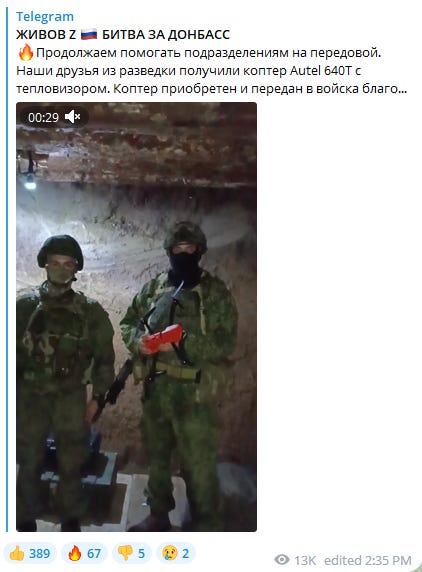
While DJI is by far the biggest player in the consumer drone sector, it’s not the only game in town. Chinese company Autel (a Chinese company that makes some products in the USA to circumvent American bans) is also quite popular among fighters in Ukraine, although its drones simply don’t seem to be manufactured in the quantities needed to satisfy combat demand.
Nor do fighters in Ukraine or anywhere else - truly need to rely on private companies to acquire an inexpensive and useful quadcopter at all, if they’ve got the right skills. Indeed, regulators around the world seem to have largely acknowledged, in the last five years or so, that banning small drones entirely is well-nigh impossible if you don’t also ban 3D printers and dirt-cheap Chinese electronics.
Ultimately, the chokepoint with DIY drones for combat isn’t really around skill. It’s much more about volume, and about manufacturing capacity. Building a drone from scratch in a war zone simply takes a hell of a lot more effort than taking one out of a box that can be up in the air in approximately 15 minutes.
Consumer, off the shelf drones that anyone with thumbs can fly didn’t create modern small drone warfare. Instead, just as small, cheap drones did with everything from aerial photography to mapping, they made aerial combat and reconnaissance much cheaper. More accessible. You could even say, if you were feeling punchy, that small drones have democratized war in the air.
I said “massively abbreviated”, so please don’t @ me unless you absolutely must about missing some specific detail of the history because that’s exactly why I’m trying to write an actual book about drones. ↩
Human beings are closely related to chimpanzees, but we’re not descended from chimpanzees: our last common ancestor was a gibbon-like thing that lived about 6 to 7 million years ago. Drones operate on a much shorter time scale, but you get the idea. ↩
Last I checked, a modern consumer quadcopter has never killed anybody from an impact injury - but large, remote-controlled model helicopters have. In one tragic incident in 2013, a 19 year old was killed when his model airplane struck him in the head. The same year, a Swiss model helicopter pilot was killed after the aircraft stuck him in the head and arms. ↩
Why weren’t quadcopters more popular in the consumer, toy trade prior to the early 2010s? In large part it’s because flying a mere single-rotor helicopter is enough of a pain in the ass for our glorified chimpanzee cerebellums, as a single glance at just how often the horrible things crash demonstrates. (As they say, if a fixed wing airplane inherently wants to fly, a helicopter inherently wants to smash into the ground and burst into flames). If a human is going to fly something with FOUR rotors with relative ease and stability - beyond that provided by a dirt-cheap toy drone- then we’ll need assistance from computers and sensors to help us do the job. The flight controller is, in essence, a drone’s “brain,” and like a human brain, it helps orchestrate input from a number of sensors. For a drone, those sensors usually include gyroscopes, accelerometers, barometers, magnetometers, GPS receivers, and more.
As for why we don’t see many manned quadcopters out and about, the simple answer is that in aeronautical engineering terms, scaling up what works for a very small aircraft that doesn’t carry a human being who can die is not nearly as easy as some people think it is. A good discussion/argument about this is here on StackExchange. ↩
In the last month, Russian volunteer groups on Telegram say they have encountered increasing friction with Russian border authorities controlling their access - and the movement of drones - into the contested border region. Reportedly this direction has come from the Russian Ministry of Defense, which may want more official oversight into what aircraft are coming and going out of Ukraine. The situation remains unclear, at least from my limited perspective. ↩
